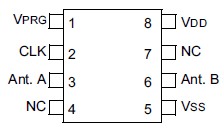Features: • Carrier frequency: 13.56 MHz
• Data modulation frequency: 70 kHz
• Manchester coding protocol
• 154 bits of user memory
• On-board 100 ms SLEEP timer
• Built-in anti-collision algorithm for reading up to multiple tags in the same RF field
• "Cloaking" feature to minimize the detuning effects of adjacent tags
• Internal 100 pF resonant capacitor (MCRF360)
• Read only device in RF field
• Long read range
• Rewritable with contact programmer or factoryprogrammed options
• Very low power CMOS design
• Die, wafer, bumped wafer, COB, PDIP or SOIC package optionsApplication• Book store and library book ID
• Airline baggage tracking
• Toys and gaming tools
• Access control/asset tracking
• Applications for reading multiple tags and long read rangePinout Specifications
Specifications
|
Parameters |
Symbol |
Min |
Max |
Units |
Conditions |
|
Coil Current |
IPP_AC |
- |
40 |
mA |
Peak-to-Peak coil current |
|
Assembly temperature |
TASM |
- |
265 |
°C |
< 10 sec |
|
Storage temperature |
TSTORE |
-65 |
150 |
°C |
- |
DescriptionThe MCRF355 and MCRF360 are Microchip's 13.56 MHz microID™ family of RFID tagging devices. They are uniquely designed read-only passive Radio Frequency Identification (RFID) devices with an advanced anti-collision feature. They are programmable with a contact programmer. The device is powered remotely by rectifying RF magnetic fields that are transmitted from the reader.
The device has a total of six pads (see Figure 1-1). Three (ant. A, B, VSS) are used to connect the external resonant circuit elements. The additional three pads (VPRG, CLK, VDD) are used for programming and testing of the device.
The device needs an external resonant circuit between antenna A, B, and VSS pads. The resonant frequency of the circuit is determined by the circuit elements between the antenna A and VSS pads. The resonant circuit must be tuned to the carrier frequency of the reader for maximum performance. The circuit element between the antenna B and VSS pads is used for data modulation. See Application Note AN707 for further operational details.
The MCRF360 includes a 100 pF internal resonant capacitor (100 pF). By utilizing this internal resonant capacitor, the device needs external coils only for the resonant circuit. Examples of the resonant circuit configuration for both the MCRF355 and MCRF360 are shown in Section 3.0.
When a tag (device with the external LC resonant circuit) is brought to the reader's RF field, it induces an RF voltage across the LC resonant circuit. The device rectifies the RF voltage and develops a DC voltage. The device becomes functional as soon as VDD reaches the operating voltage level.
The MCRF360 includes a modulation transistor that is located between antenna B and VSS pads. The transistor has high turn-off (a few M) and low turn-on (3 ) resistance. The turn-on resistance is called modulation resistance (RM). When the transistor turns off, the resonant circuit is tuned to the carrier frequency of the reader. This condition is called uncloaking. When the modulation transistor turns on, its low turn-on resistance shorts the external circuit element between the antenna B and VSS. As a result, the resonant circuit no longer resonates at the carrier frequency. This is called cloaking.
The induced voltage amplitude (on the resonant circuit) changes with the modulation data: higher amplitude during uncloaking (tuned), and lower amplitude during cloaking (detuned). This is called "amplitude modulation"signal. The receiver channel in the reader detects this amplitude modulation signal and reconstructs the modulation data.
The occurrence of the cloaking and uncloaking of the device is controlled by the modulation signal that turns the modulation transistor on and off, resulting in communication from the device to the reader.
The data stream consists of 154 bits of Manchesterencoded data at a 70 kHz rate. The Manchester code waveform is shown in Figure 2-2. After completion of the data transmission, the MCRF360 goes into SLEEP mode for about 100 ms. The device repeats the transmitting and SLEEP cycles as long as it is energized. During the SLEEP time the device remains in an uncloaked state.
SLEEP time is determined by a built-in low-current timer. There is a wide variation of the SLEEP time between each device. This wide variation of SLEEP time results in a randomness of the time slot. Each device wakes up and transmits its data in a different time slot with respect to each other. Based on this scenario, the reader is able to read many tags that are in the same RF field.
The device has a total of 154 bits of reprogrammable memory. All bits are reprogrammable by a contact programmer. A contact programmer (part number PG103003) is available from Microchip Technology Inc. Factory programming prior to shipment, known as Serialized Quick Turn ProgrammingSM (SQTPSM), is also available. The MCRF360 is available in die, wafer, bumped wafer, wafer-on-frame, PDIP, SOIC and COB modules.

 MCRF360 Data Sheet
MCRF360 Data Sheet







